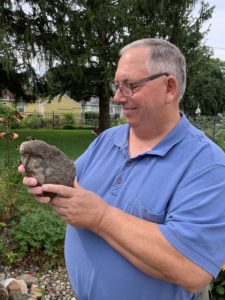
When I was about 9 or 10 years old, my next-door neighbor called to me through the break in the bushes between our houses, asking if I ever looked for rocks. He pointed to three rocks each the size of an adult’s fist laying on his freshly mowed lawn. He encouraged me to pick them up and take a good look. Then he suggested we figure out what kinds of rocks these were.
He alternated between asking me what I saw and pointing out what he saw. He would ask leading questions like: Pointing at a dark, smooth rock – Do you think the lighter streaks on this rock looks like the grain in a piece of wood?
Another rock was very rough and jagged. It looked a bit rusty. My hands got a bit dirty handling it. He said something like, Does this rock look like it was a chip off the surface of another rock or does it look like a chunk out of the middle of bigger rocks?
The third rock was sandy with multiple layers each a different shade of blush pink. I could rub off a bit of the sand with my fingers. He asked something like: Why do you think this rock was not as heavy as the other rocks?
Then we brought the rocks into his garage. He got a nail so we could see if it would leave a mark if we scraped the rock with the point of the nail. The nail did not leave a mark in the smooth rock. It made a slight scratch in the jagged rock. It made a gouge in the sandy rock.
He had me guess the kinds of rocks they were. My dad was a stonemason so I knew that the sandstone was a sandstone. Even with several hints, I did not guess the smooth rock was petrified wood. He gave me a clue that the reason the nail scratched the rusty rock was it was sort of the same as the steel nail. It was a chunk of iron ore and he said I came close with: steel rock.
He then gave me a mini-lecture about the rocks. I don’t remember what he said but I just looked up the characteristics of these type rocks. I bet what I looked up was pretty much the same as he told me. Petrified wood is actually the fossil of a tree buried in sediment with no oxygen to decay it. The iron ore had actually been mined from a formation and so the iron ore was the result of the bigger chunks being crushed into smaller chunks. He probably also described how sandstone was formed.
He had a doctorate in geology but he told me to call him Don. Not only was he a Ph.D. level geologist, but he was also the head of the Geology Department at the University of Minnesota. Until I was older I did not know to be impressed. He was just my nice neighbor.
Once a year he would invite a bunch of grad students to a backyard get-together. They would mill around Don’s back yard, holding a beer, talking to each other about whatever grad students talk about. I remember at least three of those years, Don spotted me in our backyard and called me over.
He would introduce me to a couple of the grad students then raise his voice and announce to any who would listen: “My job was to get you educated, your job is to educate the next generation like Paul here.” I was then pretty much pushed back toward my yard.
Don was a very nice guy, however other than the interactions above, while I was his neighbor, most of my interactions with him were a nod or a short hello. I had moved away from home by the time I was old enough to understand that a University Department Head was a very busy person. I was very lucky to get a lesson in geology from him.
I never had more than a minor interest in geology. It never occurred to me that I might have had an inside track if I did. I got my degree in psychology.
Once I was an adult and Don was retired, I would occasionally talk to him and his wife at Target or the funeral of a person from the neighborhood etc. Don passed at age 91 in 2009. We attended his funeral. His wife is still alive and we exchange Christmas cards with her every year.
I got to keep the rocks. The piece of petrified wood is now part of a stone fireplace in the cabin our family used to own. My dad put it there, at my request, when he built the fireplace. I have no idea where the other two rocks ended up.
The closer you look the more you see
www.scaleandperception.com